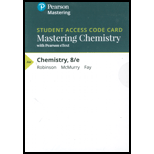
Concept explainers
(a)
Interpretation:
The complete electron dot structure of given alcohol needs to be drawn and the molecular formula of the
Concept introduction:
The line drawing is a chemical structure in which carbon and hydrogen molecules are not drawn. In these types of structures, lines are used to draw structure representing molecules. In the electron dot structure, the lone pair of electrons are represented as two dots on the respective symbol of the atom.
A molecular formula is a chemical formula that tells the total number of atoms of each element in a molecule.
(b)
Interpretation:
The complete electron dot structure of given
Concept introduction:
The line drawing is a chemical structure in which carbon and hydrogen molecules are not drawn. In these types of structures, lines are used to draw structure representing molecules. In the electron dot structure, the lone pair of electrons are represented as two dots on the respective symbol of the atom.
A molecular formula is a chemical formula that tells the total number of atoms of each element in a molecule.
(c)
Interpretation:
The complete electron dot structure of given cyclic amine needs to be drawn and the molecular formula of the alkane with cyclic amine group needs to be determined.
Concept introduction:
The line drawing is a chemical structure in which carbon and hydrogen molecules are not drawn. In these types of structures, lines are used to draw structure representing molecules. In the electron dot structure, the lone pair of electrons are represented as two dots on the respective symbol of the atom.
A molecular formula is a chemical formula that tells the total number of atoms of each element in a molecule.
(d)
Interpretation:
The complete electron dot structure of the given ether needs to be drawn and the molecular formula of the alkane with ether group needs to be determined.
Concept introduction:
The line drawing is a chemical structure in which carbon and hydrogen molecules are not drawn. In these types of structures, lines are used to draw structure representing molecules. In the electron dot structure, the lone pair of electrons are represented as two dots on the respective symbol of the atom.
A molecular formula is a chemical formula that tells the total number of atoms of each element in a molecule.
(e)
Interpretation:
The complete electron dot structure of given
Concept introduction:
The line drawing is a chemical structure in which carbon and hydrogen molecules are not drawn. In these types of structures, lines are used to draw structure representing molecules. In the electron dot structure, the lone pair of electrons are represented as two dots on the respective symbol of the atom.
A molecular formula is a chemical formula that tells the total number of atoms of each element in a molecule.
(f)
Interpretation:
The complete electron dot structure of the given
Concept introduction:
The line drawing is a chemical structure in which carbon and hydrogen molecules are not drawn. In these types of structures, lines are used to draw structure representing molecules. In the electron dot structure, the lone pair of electrons are represented as two dots on the respective symbol of the atom.
A molecular formula is a chemical formula that tells the total number of atoms of each element in a molecule.
Want to see the full answer?
Check out a sample textbook solution
Chapter 23 Solutions
CHEMISTRY-MASTERINGCHEMISTRY W/ETEXT
- Identify and provide an explanation of the operational principles behind a Atomic Absorption Spectrometer (AAS). List the steps involved.arrow_forwardInstructions: Complete the questions in the space provided. Show all your work 1. You are trying to determine the rate law expression for a reaction that you are completing at 25°C. You measure the initial reaction rate and the starting concentrations of the reactions for 4 trials. BrO³¯ (aq) + 5Br¯ (aq) + 6H* (aq) → 3Br₂ (l) + 3H2O (l) Initial rate Trial [BrO3] [H*] [Br] (mol/L) (mol/L) | (mol/L) (mol/L.s) 1 0.10 0.10 0.10 8.0 2 0.20 0.10 0.10 16 3 0.10 0.20 0.10 16 4 0.10 0.10 0.20 32 a. Based on the above data what is the rate law expression? b. Solve for the value of k (make sure to include proper units) 2. The proposed reaction mechanism is as follows: i. ii. BrО¸¯ (aq) + H+ (aq) → HBrO3 (aq) HBrO³ (aq) + H* (aq) → H₂BrO3* (aq) iii. H₂BrO³* (aq) + Br¯ (aq) → Br₂O₂ (aq) + H2O (l) [Fast] [Medium] [Slow] iv. Br₂O₂ (aq) + 4H*(aq) + 4Br(aq) → 3Br₂ (l) + H2O (l) [Fast] Evaluate the validity of this proposed reaction. Justify your answer.arrow_forwardе. Д CH3 D*, D20arrow_forward
- H3C. H3C CH 3 CH 3 CH3 1. LDA 2. PhSeCl 3. H2O2arrow_forwardPlease predict the products for each of the following reactions: 1.03 2. H₂O NaNH, 1. n-BuLi 2. Mel A H₂ 10 9 0 H2SO4, H₂O HgSO4 Pd or Pt (catalyst) B 9 2 n-BuLi ♡ D2 (deuterium) Lindlar's Catalyst 1. NaNH2 2. EtBr Na, ND3 (deuterium) 2. H₂O2, NaOH 1. (Sia)2BH с Darrow_forwardin the scope of ontario SCH4U grade 12 course, please show ALL workarrow_forward
- Is the chemical reaction CuCl42-(green) + 4H2O <==> Cu(H2O)42+(blue) + 4Cl- exothermic or endothermic?arrow_forwardIf we react tetraethoxypropane with hydrazine, what is the product obtained (explain its formula). State the reason why the corresponding dialdehyde is not used.arrow_forwarddrawing, no aiarrow_forward
 Introductory Chemistry: An Active Learning Approa...ChemistryISBN:9781305079250Author:Mark S. Cracolice, Ed PetersPublisher:Cengage LearningChemistry: Matter and ChangeChemistryISBN:9780078746376Author:Dinah Zike, Laurel Dingrando, Nicholas Hainen, Cheryl WistromPublisher:Glencoe/McGraw-Hill School Pub Co
Introductory Chemistry: An Active Learning Approa...ChemistryISBN:9781305079250Author:Mark S. Cracolice, Ed PetersPublisher:Cengage LearningChemistry: Matter and ChangeChemistryISBN:9780078746376Author:Dinah Zike, Laurel Dingrando, Nicholas Hainen, Cheryl WistromPublisher:Glencoe/McGraw-Hill School Pub Co

